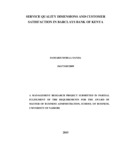| dc.description.abstract | The study focused on assessing the service quality dimensions and customer satisfaction in
Barclays bank of Kenya. The specific objectives were to determine levels of service quality and
levels of customer satisfaction using the SERVQUAL dimensions do an intersegment
comparison and finally establish a relationship between service quality and customer satisfaction.
The data was collected by use of self –administered questionnaires. Data collected was purely
quantitative and was analyzed by descriptive analysis. Descriptive statistics such as frequency,
mean, standard deviation range and standard error of mean and sum were used to analyze the
data. Tables were used to summarize responses for further analysis and facilitate comparison.
ANOVA tests were used to analyze disparities in means and correlations were done to ascertain
relationships among variables,i.e perceptions of service quality and customer satisfaction in
Barclays bank of Kenya. The study found that service quality levels were perceived to be quite
high with superior service in the affluent segment this being a resultant of segmentation, as the
mass segment service was inferior. The ranking of SERVQUAL dimensions was in the following
order, empathy first, assurance second, tangibles third, responsiveness fourth and reliability last.
Customers were satisfied on very few attributes and on the SERVQUAL dimensions customers
were generally dissatisfied with an exception of the empathy dimension whereby the
expectations were just met. The customer satisfaction was not exceptional despite the perceived
quality being superior. Service quality is generally good in Barclays bank of Kenya but there is
need for improvement as customers are not satisfied in most areas. More can be done to exceed
customers ‘expectations on all the dimensions of service quality i.e. tangibility, reliability,
responsiveness, assurance and empathy. Segmentation has improved service quality especially in
the affluent segment as per indication of superior service. The mass segment needs to be addressed especially on the reliability dimension. The affluent segment is very sensitive, despite service quality being high, this segment needs a lot of personalized service and expectations are relatively high. In the business segment, transactions’ being done within SLA’s is critical and should be adhered to. | en_US |

